Urban Floods Adaptation and Sustainable Drainage Measures
Abstract
:1. Introduction
2. The Sustainability in the Urban Drainage
2.1. The Impact of Urbanization
- Physical features of the aquatic environment, e.g., rivers, streams, and canals;
- Characteristics of the basin/flood plain and associated habitats; and
- Characteristic of the socio-economic occupation.
2.2. Sustainable Urban Drainage (SUD)
- Mitigation of accidents that can result in pollution incidents;
- The reduction of polluting activities;
- Reducing emissions of polluting materials; and
- Collection and water treatment.
2.3. Floods Mitigation Measures
- Runoff control basins are essentially applied to flow storage when the drainage network is not ready to meet new peak flows caused by recent urbanization.
- Drainage ditches or infiltration trenches are drainage devices that help to reduce the runoff and increase groundwater recharge;
- Ditches lined with vegetation and bio-swales are a type of measures that could be applied along streets or roads. With longitudinal development, these devices are located in open spaces, with existing plants tolerant to flooding and erosion resistance.
- Paving alternative can be used in areas with high rates of urbanization, allowing by itself the runoff control and providing an aesthetically pleasing solution.
- Infiltration wells permit conducting surface runoff into the soil.
- Micro-reservoirs, conduit storage and permeable pipes are urban storage elements for the flow produced in the urban residential and commercial areas.
- Green roofs compensate the related impervious areas of the building implementation, which allows using their covering for storage pluvial draining.
- Rain Gardens take advantage of topographical depressions of the land through the pluvial water collecting.
- Storage Blocks are structures made of ultra-lightweight, modular, of polypropylene to provide storage of ground water runoff, to mitigate the storm water or the infiltration.
3. Model Simulation
4. Application to a Real Basin
4.1. Case Study
4.1.1. Characteristics of the Studied Basin
4.1.2. Parameters of the Hydrological Basin
4.2. Simulated Scenarios
4.3. Analysis of Results
5. Conclusions
Acknowledgments
Author Contributions
Conflicts of Interest
Abbreviations
| EEA | European Environment Agency |
| IDF | Intensity–duration–frequency curves |
| SCS | Soil Conservation Service |
| SUD | Sustainable Urban Drainage |
| SUDS | Sustainable Urban Drainage Systems |
References
- Santos, R. Urban Floods and Constructive Measures for Its Mitigation. Master’s Thesis, Universidade Técnica de Lisboa (I.S.T), Lisbon, Portugal, 2011. [Google Scholar]
- Neal, J.; Villanueva, I.; Wright, N.; Willis, T.; Fewtrell, T.; Bates, P.D. How much physical complexity is needed to model flood inundation? Hydrol. Process. 2012, 26, 2264–2282. [Google Scholar] [CrossRef]
- Miller, J.D.; Hutchins, M. The impacts of urbanisation and climate change on urban flooding and urban water quality: A review of the evidence concerning the United Kingdom. J. Hydrol. Reg. Stud. 2017, 12, 345–362. [Google Scholar] [CrossRef]
- Néelz, S.; Pender, G. Benchmarking of 2D Hydraulic Modelling Packages, SC080035/SR2; Environment Agency: Bristol, UK, 2010.
- Jha, A.K.; Lamond, R.B.J. Cities and Flooding: A Guide to Integrated Urban Flood Risk Management for the 21st Century; World Bank: Washington, DC, USA, 2012; ISBN 978-0-8213-9477-9. [Google Scholar]
- Costabile, P.; Costanzo, C.; Macchione, F. Performances and limitations of the diffusive approximation of the 2-D shallow water equations for flood simulation in urban and rural areas. Appl. Numer. Math. 2017, 116, 141–156. [Google Scholar] [CrossRef]
- Ashley, R.M.; Balmforth, D.J.; Saul, A.J.; Blansk, J.D. Flooding in the future–predicting climate change, risks and responses in urban areas. Water Sci. Technol. J. Int. Assoc. Water Pollut. Res. 2005, 5, 265–273. [Google Scholar]
- Fowler, H.J.; Wilby, R.L. Detecting changes in seasonal precipitation extremes using regional climate model projections: implications for managing fluvial flood risk. Water Resour. Res. 2010, 46, 1–17. [Google Scholar] [CrossRef]
- Jacobson, C.R. Identification and quantification of the hydrological impacts of imperviousness in urban catchments: A review. J. Environ. Manag. 2011, 92, 1438–1448. [Google Scholar] [CrossRef] [PubMed]
- Perales-Momparler, S.; Hernández-Crespo, C.; Vallés-Morán, F.J.; Martín-Monerris, M.; Andrés-Doménech, I.; Álvarez, J.A. SUDS efficiency during the start-up period under Mediterranean climatic conditions. CLEAN-Soil Air Water 2014, 2, 178–186. [Google Scholar] [CrossRef]
- Brath, A.; Montanari, A.; Moretti, G. Assessing the Effects on Flood Risk of the Land-Use Changes in the Last Five Decades: an Italian Case Study. In Proceedings of the International Symposium ‘Hydrology of Meditterranean and Semiarid Regions’, Montpellier, France, 1–4 April 2003. IAHS Publications, No. 278. [Google Scholar]
- Hutchins, M.G.; McGrane, S.J.; Miller, J.D. Integrated modeling in urban hydrology: Reviewing the role of monitoring technology in overcoming the issue of ‘big data’ requirements. Water 2016, 4, 1–24. [Google Scholar] [CrossRef]
- Fordham, M. Participatory Planning for Flood Mitigation: Models and Approaches. In Floods Volume II; Parker, D.J., Ed.; Routledge: London, UK, 2000; pp. 66–79. [Google Scholar]
- Ramos, H.M. Mathematic Models for Simulation Unsteady Flows in Open Channels. Master’s Thesis, Universidade Técnica de Lisboa (I.S.T), Lisbon, Portugal, 1986. (In Portuguese). [Google Scholar]
- Geldof, G.D. Adaptative water management: Integrated water management on the edge of chaos. Water Sci. Technol. 1995, 32, 7–13. [Google Scholar]
- CivilStorm® Comprehensive Stormwater Modeling and Analysis. Available online: https://www.bentley.com/pt/products/product-line/hydraulics-and-hydrology-software/civilstorm (accessed on 15 March 2017).
- Wilson, S.; Bray, R.; Cooper, P. Sustainable Urban Drainage Systems; Hydraulic, Structural and Water Quality Advice (C609); CIRIA: London, UK, 2004. [Google Scholar]
- Shaffer, P.; Elliott, C.; Reed, J.; Holmes, J.; Ward, M. Model Agreements for Sustainable Water Management Systems, Model Agreement for Rainwater and Greywater Use Systems; CIRIA: London, UK, 2004. [Google Scholar]
- Virginia Department of Conservation and Recreational Resources. Stormwater Management Handbook: Implementing Green Infrastructure in Northern Kentucky Communities; Nevue Ngan Associates Eisen: Portland, OR, USA; Letunic Van Meter Williams Pollack LLP ICF International: Fairfax, VA, USA, 2009.
- Brandão, C.; Hipólito, J.N. Curvas de Possibilidade Udométrica (IDF) para Aveiro, Lisboa, Évora e Faro. Revista da APRH 1997, 18, 45–52. [Google Scholar]
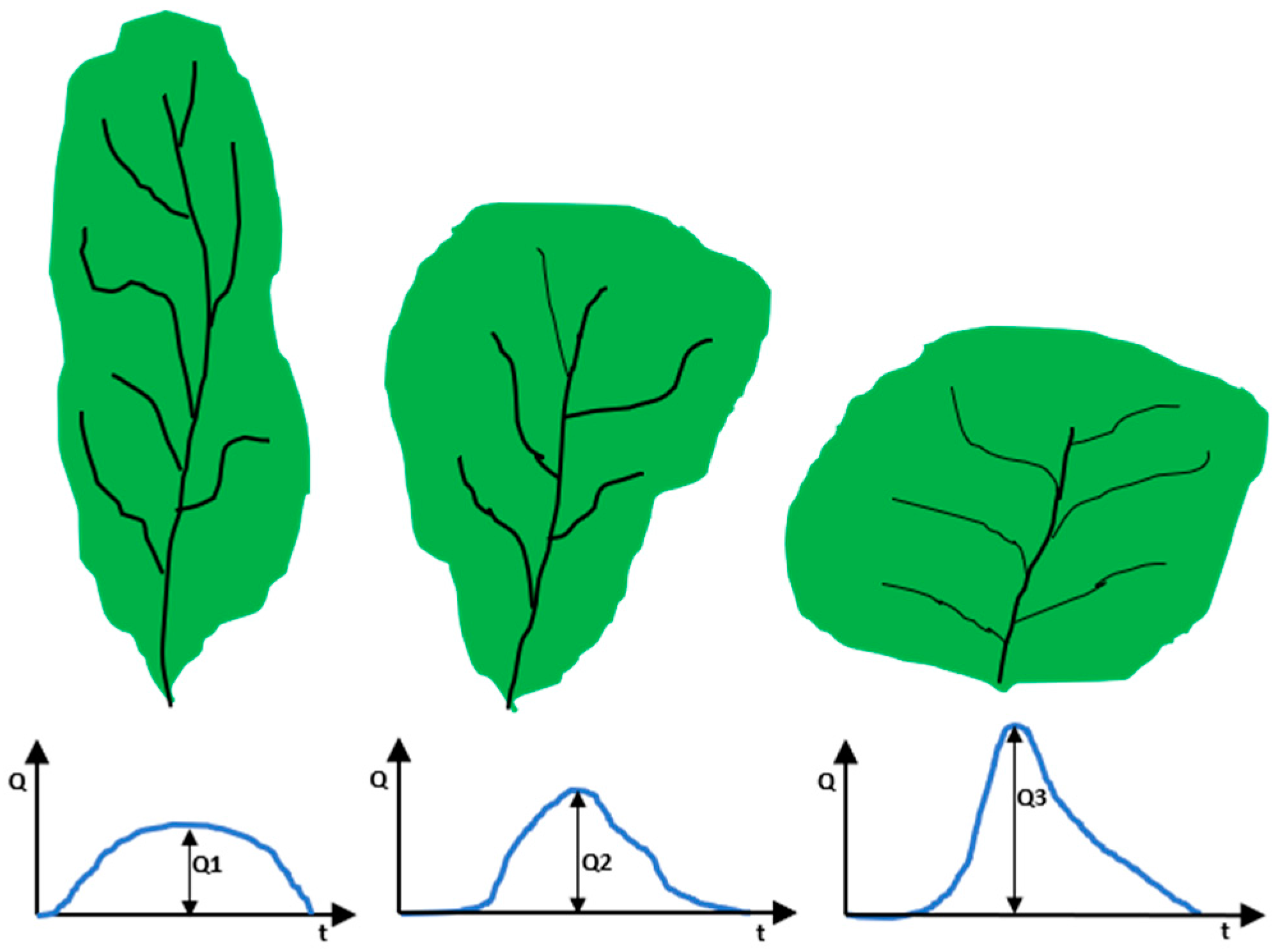
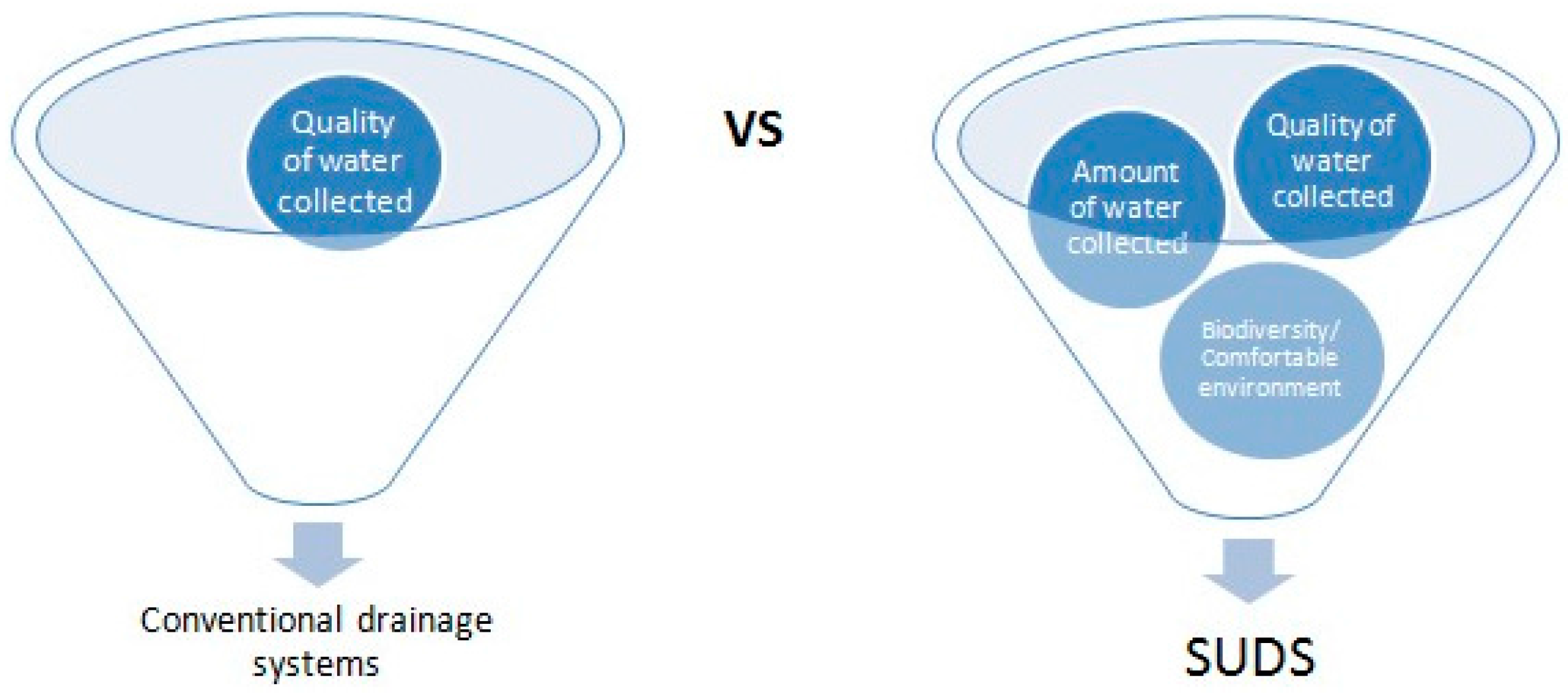
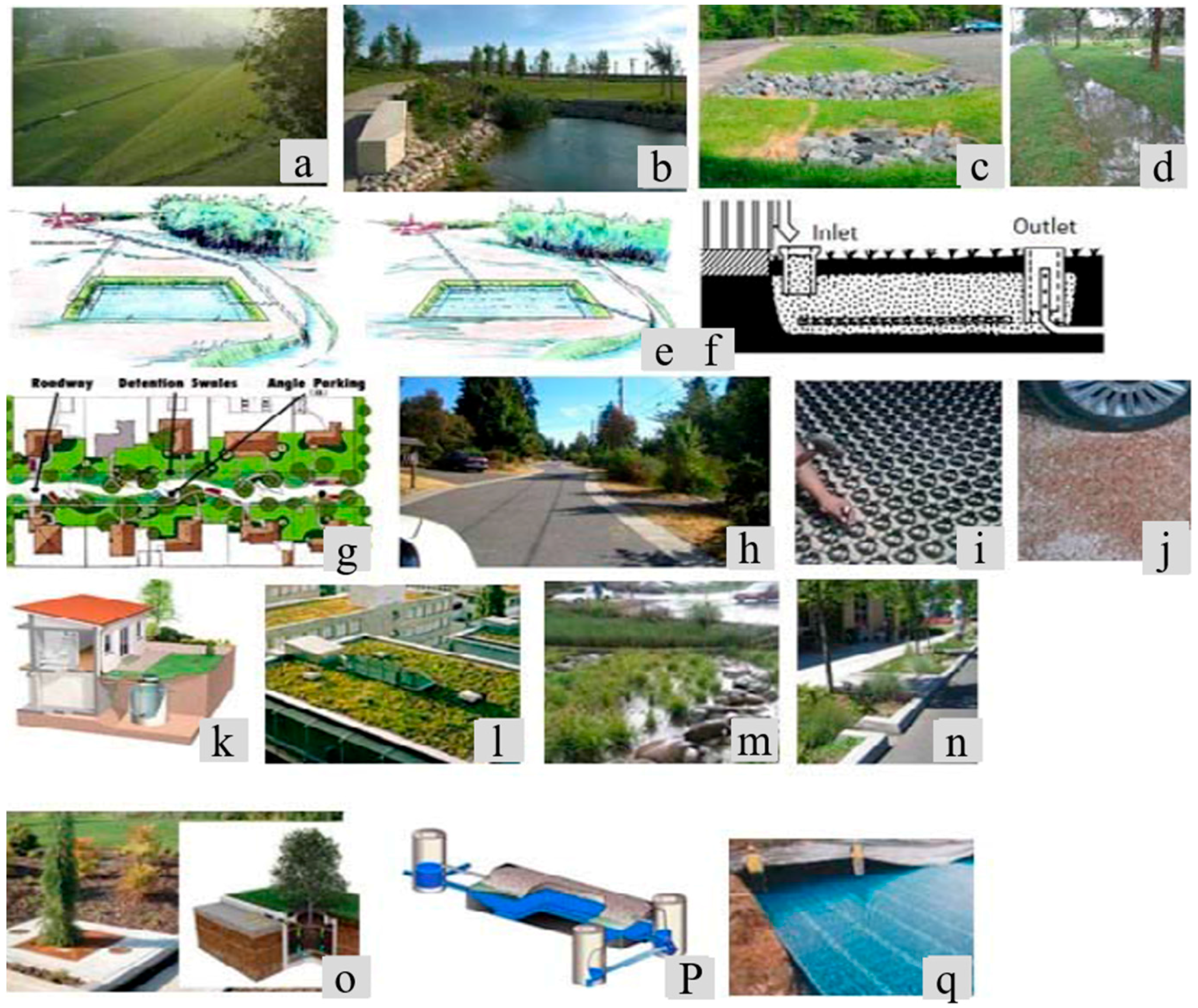

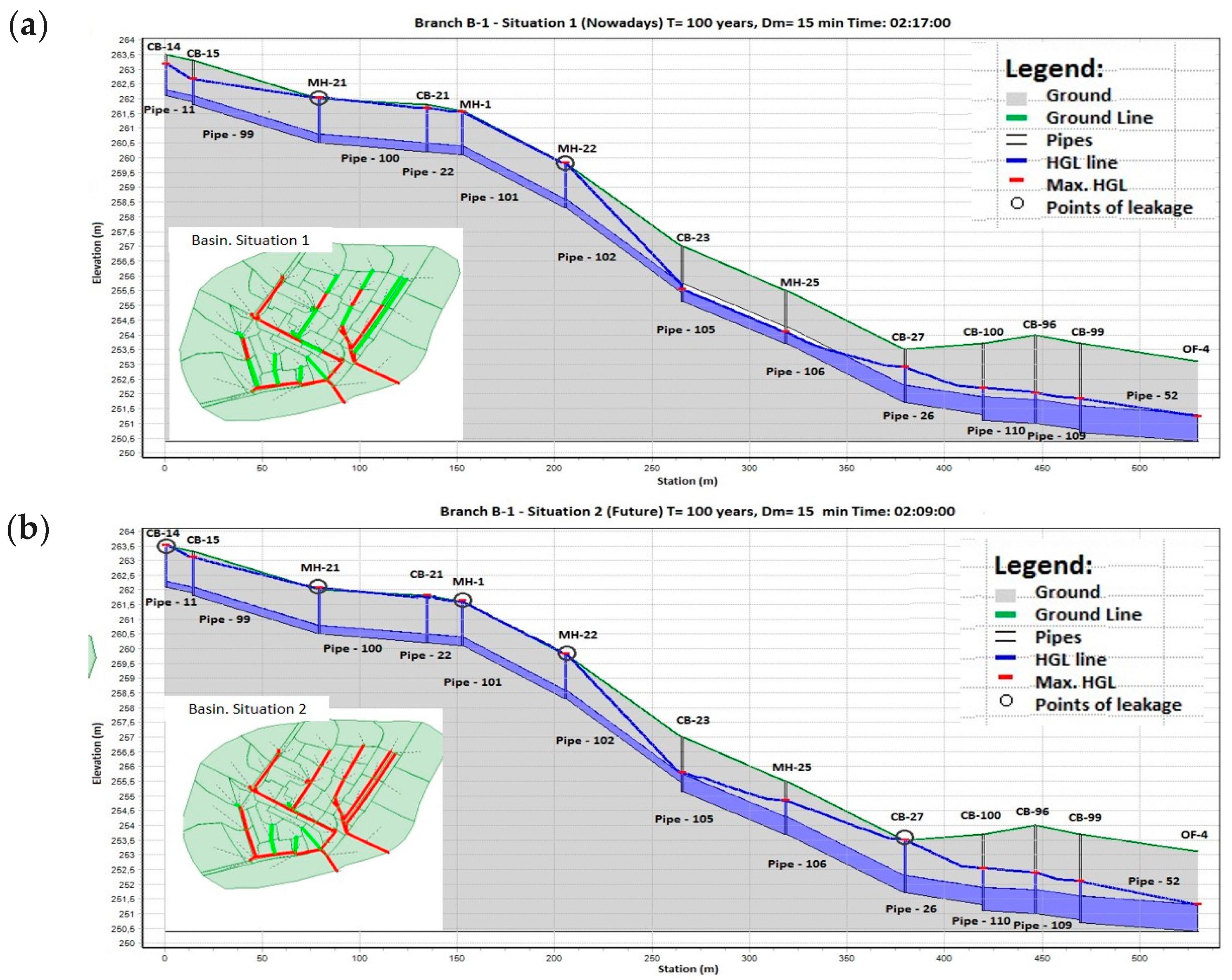
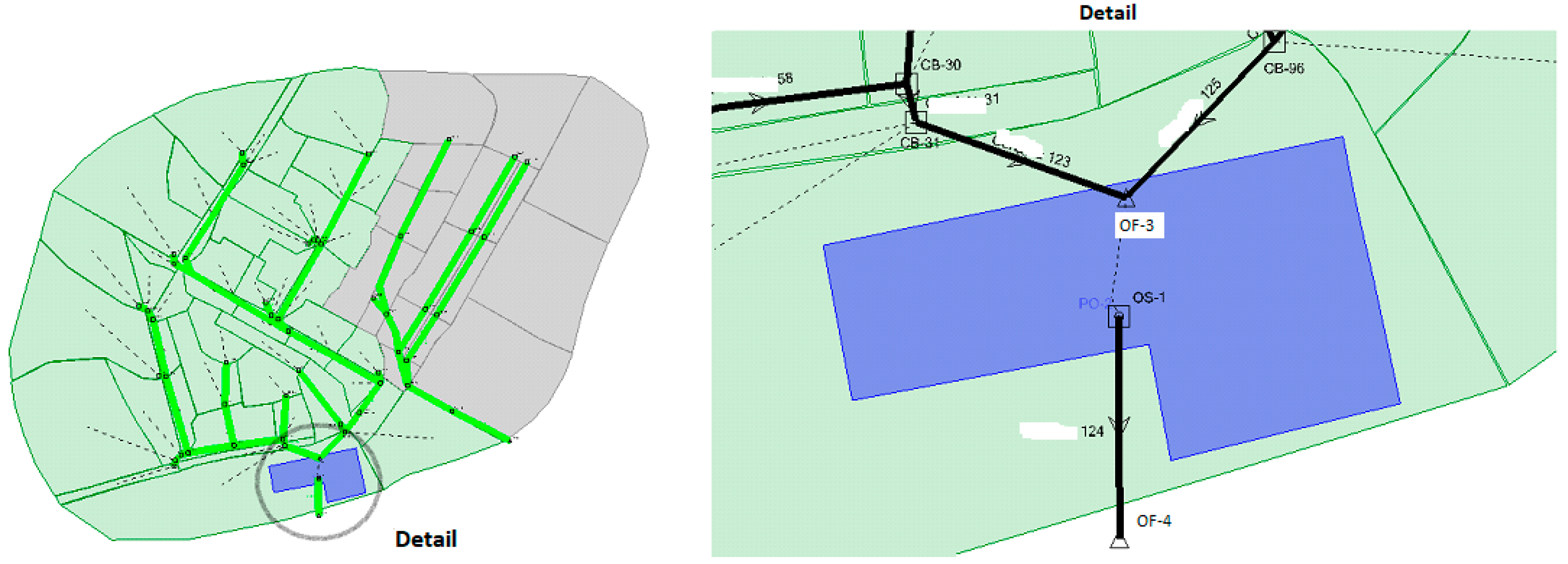
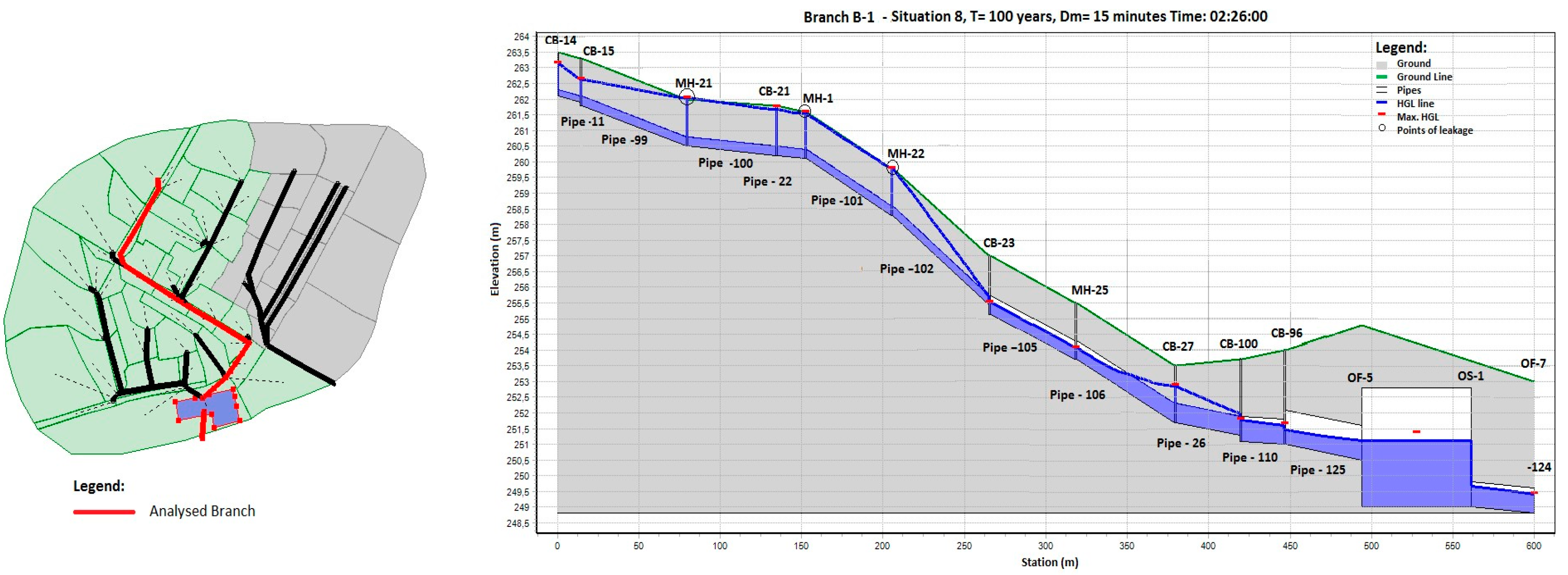
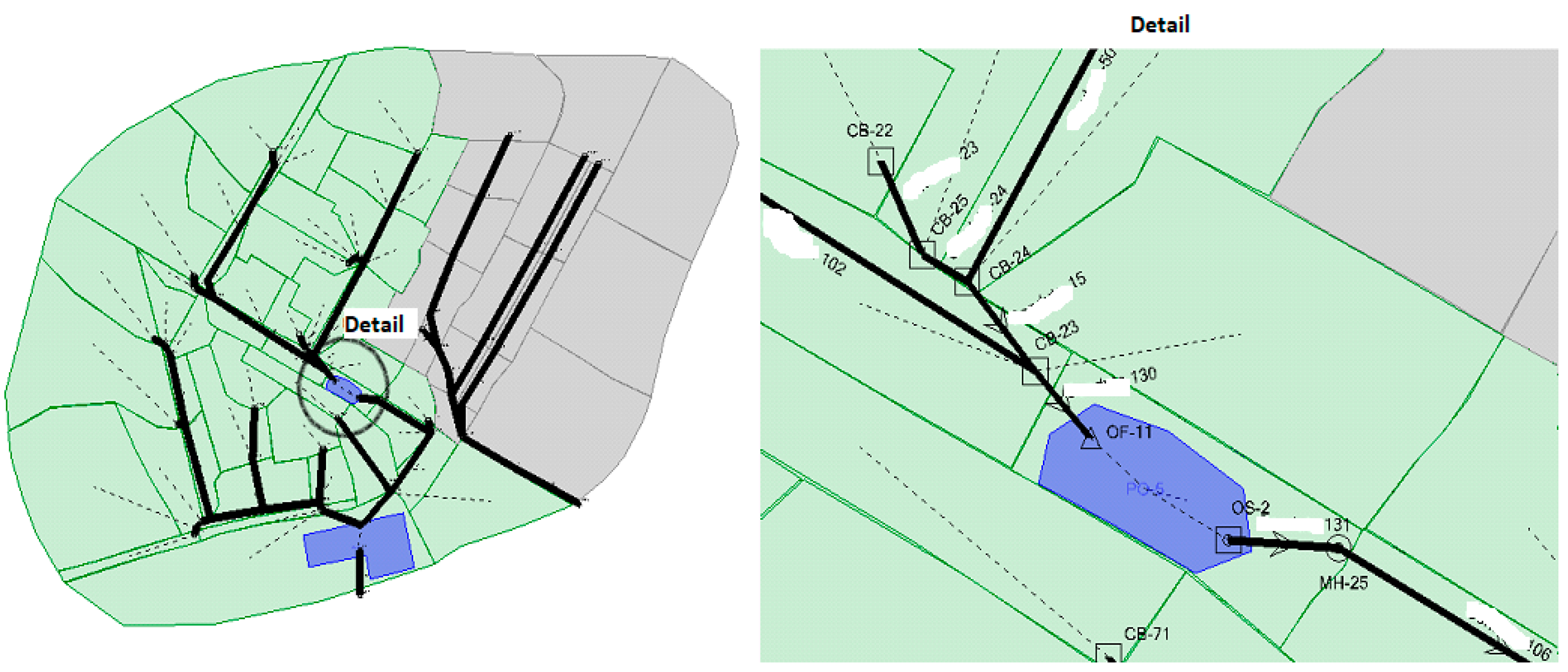

| Constructive Causes | Impacts |
|---|---|
| Removal of Native Vegetation | Increased volume of runoff and maximum flows Increased runoff velocity Increased vulnerability of the land against erosion Deposition of sediments leading to blockages in pipes and streams |
| Implantation of Artificial Drainage Network | Significant increase in runoff velocity and peak flows Inadequate drainage works, e.g., diameters of pipes with reduced cross-section leading to extensions of the inundation areas |
| Construction in River Areas | Exposure to flooding in areas naturally flooded Expansion of wetlands and localized flooding resulting from reductions in sections of the drainage system |
| Area (km2) | Perimeter (km) | Length of the Main Line (km) | Mean Elevation (m) | Maximum Elevation/ Minimum Elevation (m) | Average Slope (%) |
|---|---|---|---|---|---|
| 0.27 | 1.90 | 0.52 | 60 | 65/53 | 4.5 |
| Scenario | Type of Land Use | Area (m2) | Occupied Area (%) | Scenario | Type of Land Use | Area (m2) | Occupied Area (%) |
|---|---|---|---|---|---|---|---|
| 1 (Nowadays) | Green areas/ vacant lots | 167,320 | 62 | 2 (Future) | Green areas/ vacant lots | 109,130 | 41 |
| Built up areas | 88,890 | 33 | Built up areas | 143,270 | 53 | ||
| Paved areas | 13,420 | 5 | Paved areas | 17,230 | 6 |
| Scenario | Features | Scenario | Features |
|---|---|---|---|
| 1 | Current occupation of the study area | 6 | Green roofs and permeable paving applied to 90% of impermeable areas |
| 2 | Future occupation of the study area | 7 | Application of drainage ditches |
| 3 | Green roofs and permeable paving applied to 30% of impermeable areas | 8 | Application of a retention pond |
| 4 | Green roofs and permeable paving applied to 50% of impermeable areas | 9 | Application of a retention pond and underground storage blocks |
| 5 | Green roofs and permeable paving applied to 70% of impermeable areas | 10 | Resizing some parts of the drainage network in combination with other scenarios |
| Scenarios | Percentage of Occupation (%) | Permeable Paving Areas (m2) | Green Roofs Areas (m2) | Total Area of Application (m2) |
|---|---|---|---|---|
| 3 | 30 | 5169 | 42,981 | 48,150 |
| 4 | 50 | 8615 | 71,635 | 80,250 |
| 5 | 70 | 12,061 | 100,289 | 112,350 |
| 6 | 90 | 15,507 | 128,943 | 144,450 |
| T (years) | Dm (min) | Variations in the Peak Flow (m3/s) | ||||||
|---|---|---|---|---|---|---|---|---|
| Scenario 2 vs. 1 | Scenario 3 vs. 2 | Scenario 4 vs. 2 | Scenario 5 vs. 2 | Scenario 6 vs. 2 | Scenario 7 vs. 1 | Scenario 4 vs. 2 | ||
| Discharge Point OF-1 | ||||||||
| 2 | 5 | 0.16 | −0.08 | −0.08 | −0.08 | −0.08 | 0.00 | −0.01 |
| 15 | 0.13 | −0.07 | −0.08 | −0.08 | −0.08 | 0.00 | −0.01 | |
| 30 | 0.09 | −0.06 | −0.07 | −0.07 | −0.07 | 0.00 | −0.01 | |
| 60 | 0.06 | −0.04 | −0.05 | −0.05 | −0.05 | 0.00 | −0.01 | |
| 90 | 0.04 | −0.03 | −0.04 | −0.04 | −0.04 | 0.00 | 0.00 | |
| 5 | 5 | 0.28 | −0.12 | −0.14 | −0.15 | −0.15 | −0.01 | −0.01 |
| 15 | 0.22 | −0.10 | −0.13 | −0.14 | −0.14 | −0.01 | −0.02 | |
| 30 | 0.14 | −0.07 | −0.10 | −0.11 | −0.11 | 0.00 | −0.02 | |
| 60 | 0.08 | −0.05 | −0.07 | −0.08 | −0.08 | −0.01 | −0.01 | |
| 90 | 0.06 | −0.03 | −0.05 | −0.07 | −0.07 | −0.01 | −0.01 | |
| 10 | 5 | 0.34 | −0.12 | −0.16 | −0.17 | −0.17 | −0.01 | −0.04 |
| 15 | 0.27 | −0.11 | −0.15 | −0.17 | −0.17 | −0.01 | −0.02 | |
| 30 | 0.16 | −0.07 | −0.11 | −0.13 | −0.14 | −0.01 | −0.02 | |
| 60 | 0.09 | −0.04 | −0.07 | −0.09 | −0.10 | −0.01 | −0.01 | |
| 90 | 0.07 | −0.04 | −0.06 | −0.08 | −0.09 | −0.01 | −0.01 | |
| 20 | 5 | 0.35 | −0.11 | −0.09 | −0.17 | −0.18 | −0.01 | −0.09 |
| 15 | 0.30 | −0.07 | −0.16 | −0.19 | −0.19 | −0.02 | −0.12 | |
| 30 | 0.18 | −0.08 | −0.13 | −0.15 | −0.16 | −0.01 | −0.01 | |
| 60 | 0.10 | −0.05 | −0.08 | −0.11 | −0.12 | −0.01 | −0.01 | |
| 90 | 0.07 | −0.03 | −0.06 | −0.08 | −0.09 | −0.02 | −0.01 | |
| 50 | 5 | 0.30 | −0.10 | −0.08 | −0.11 | −0.12 | −0.02 | −0.09 |
| 15 | 0.31 | −0.04 | −0.05 | −0.06 | −0.07 | −0.03 | −0.13 | |
| 30 | 0.19 | −0.04 | −0.05 | −0.17 | −0.18 | −0.02 | −0.03 | |
| 60 | 0.11 | −0.05 | −0.09 | −0.12 | −0.14 | −0.02 | −0.02 | |
| 90 | 0.07 | −0.04 | −0.07 | −0.09 | −0.11 | −0.01 | −0.01 | |
| 100 | 5 | 0.17 | −0.04 | −0.05 | −0.05 | −0.04 | −0.04 | −0.10 |
| 15 | 0.26 | −0.03 | −0.04 | −0.09 | −0.09 | −0.05 | −0.14 | |
| 30 | 0.14 | −0.04 | −0.05 | −0.08 | −0.09 | −0.02 | −0.03 | |
| 60 | 0.10 | −0.02 | −0.07 | −0.12 | −0.15 | −0.02 | −0.03 | |
| 90 | 0.07 | −0.05 | −0.07 | −0.09 | −0.12 | −0.01 | −0.02 | |
| T (years) | Dm (min) | Variations in the Peak Flow (m3/s) | ||||||||
|---|---|---|---|---|---|---|---|---|---|---|
| Scenario 2 vs. 1 | Scenario 3 vs. 2 | Scenario 4 vs. 2 | Scenario 5 vs. 2 | Scenario 6 vs. 2 | Scenario 8 vs. 1 | Scenario 8 vs. 2 | Scenario 9 vs. 1 | Scenario 8 vs. 1 | ||
| Discharge Point OF-2 | ||||||||||
| 2 | 5 | 0.45 | −0.21 | −0.24 | −0.24 | −0.24 | −0.01 | −0.26 | −0.02 | −0.27 |
| 15 | 0.37 | −0.19 | −0.24 | −0.24 | −0.24 | −0.02 | −0.19 | −0.02 | −0.19 | |
| 30 | 0.24 | −0.14 | −0.18 | −0.18 | −0.19 | −0.01 | −0.06 | −0.01 | −0.06 | |
| 60 | 0.15 | −0.09 | −0.13 | −0.13 | −0.14 | −0.01 | −0.03 | −0.01 | −0.04 | |
| 90 | 0.11 | −0.07 | −0.10 | −0.11 | −0.11 | 0.00 | −0.01 | 0.00 | −0.01 | |
| 5 | 5 | 0.65 | −0.21 | −0.28 | −0.30 | −0.31 | −0.13 | −0.65 | −0.13 | −0.66 |
| 15 | 0.56 | −0.25 | −0.34 | −0.36 | −0.37 | −0.15 | −0.60 | −0.15 | −0.60 | |
| 30 | 0.36 | −0.19 | −0.28 | −0.30 | −0.30 | −0.11 | −0.35 | −0.11 | −0.36 | |
| 60 | 0.21 | −0.12 | −0.18 | −0.21 | −0.22 | −0.03 | −0.12 | −0.03 | −0.12 | |
| 90 | 0.15 | −0.09 | −0.14 | −0.18 | −0.19 | −0.02 | −0.07 | −0.02 | −0.07 | |
| 10 | 5 | 0.67 | −0.18 | −0.28 | −0.32 | −0.34 | −0.29 | −0.85 | −0.29 | −0.86 |
| 15 | 0.59 | −0.21 | −0.32 | −0.36 | −0.37 | −0.34 | −0.79 | −0.34 | −0.81 | |
| 30 | 0.42 | −0.21 | −0.32 | −0.37 | −0.38 | −0.26 | −0.56 | −0.26 | −0.57 | |
| 60 | 0.24 | −0.13 | −0.21 | −0.26 | −0.28 | −0.12 | −0.27 | −0.12 | −0.28 | |
| 90 | 0.17 | −0.10 | −0.16 | −0.20 | −0.23 | −0.06 | −0.16 | −0.06 | −0.16 | |
| 20 | 5 | 0.52 | −0.14 | −0.12 | −0.21 | −0.22 | −0.48 | −0.90 | −0.49 | −0.91 |
| 15 | 0.48 | −0.08 | −0.20 | −0.25 | −0.27 | −0.53 | −0.92 | −0.53 | −0.93 | |
| 30 | 0.34 | −0.10 | −0.22 | −0.30 | −0.33 | −0.42 | −0.67 | −0.42 | −0.68 | |
| 60 | 0.25 | −0.13 | −0.22 | −0.29 | −0.33 | −0.25 | −0.39 | −0.26 | −0.40 | |
| 90 | 0.18 | −0.10 | −0.17 | −0.23 | −0.26 | −0.16 | −0.23 | −0.17 | −0.24 | |
| 50 | 5 | 0.46 | −0.13 | −0.12 | −0.19 | −0.27 | −0.72 | −1.07 | −0.73 | −1.13 |
| 15 | 0.32 | −0.06 | −0.10 | −0.12 | −0.12 | −0.79 | −1.07 | −0.79 | −1.07 | |
| 30 | 0.20 | −0.05 | −0.09 | −0.20 | −0.23 | −0.66 | −0.81 | −0.67 | −0.81 | |
| 60 | 0.22 | −0.09 | −0.19 | −0.27 | −0.33 | −0.42 | −0.56 | −0.42 | −0.57 | |
| 90 | 0.19 | −0.11 | −0.18 | −0.25 | −0.30 | −0.27 | −0.39 | −0.27 | −0.40 | |
| 100 | 5 | 0.32 | −0.05 | −0.09 | −0.09 | −0.10 | −0.88 | −1.15 | −0.88 | −1.15 |
| 15 | 0.28 | −0.05 | −0.10 | −0.13 | −0.14 | −0.89 | −1.12 | −0.89 | −1.12 | |
| 30 | 0.16 | −0.05 | −0.07 | −0.11 | −0.16 | −0.78 | −0.89 | −0.79 | −0.89 | |
| 60 | 0.10 | −0.03 | −0.08 | −0.18 | −0.24 | −0.59 | −0.62 | −0.59 | −0.63 | |
| 90 | 0.16 | −0.07 | −0.15 | −0.22 | −0.29 | −0.41 | −0.50 | −0.41 | −0.51 | |
| Method | OF-1 tc (min) | OF-2 tc (min) |
|---|---|---|
| Kirpich | 12 | 11 |
| Carter | 13 | 12 |
| Temez | 12 | 11 |
| Ven Te Chow | 11 | 12 |
| Kerby/Hathaway | 12 | 13 |
| Federal Aviation Agency | 30 | 27 |
| SCS Lag | 22 | 20 |
| Giandotti | 10 | 10 |
| Kinematic wave- Manning | 11 | 11 |
| Average concentration time | 15 | 14 |
| T (years) | Dm (min) | Peak Flow Volume (m3) | ||||
|---|---|---|---|---|---|---|
| Scenario 1 | Scenario 7 Applied on 1 | Scenario 1 | Scenario 8 Applied on 1 | Scenario 9 Applied on 1 | ||
| VOF-1 (m3) | VOF-2 (m3) | |||||
| 50 | 15 | 1.28 | 0.00 | 9.06 | 1.49 | 0.00 |
| 100 | 15 | 3.63 | 3.51 | 78.68 | 15.96 | 2.22 |
| 30 | 9.15 | 7.82 | 170.41 | 45.72 | 7.57 | |
| 60 | 6.69 | 4.61 | 108.31 | 12.38 | 2.05 | |
| T (years) | Dm (min) | Peak Flow Volume (m3) | |||||
|---|---|---|---|---|---|---|---|
| Scenario 2 | Scenario 3 Applied on 2 | Scenario 4 Applied on 2 | Scenario 5 Applied on 2 | Scenario 6 Applied on 2 | Scenario 7 Applied on 2 | ||
| 20 | 15 | 1.65 | 0.00 | 0.00 | 0.00 | 0.00 | 0.00 |
| 50 | 5 | 31.82 | 22.05 | 13.46 | 7.88 | 5.48 | 2.04 |
| 15 | 20.70 | 14.15 | 12.15 | 9.30 | 0.24 | 17.14 | |
| 30 | 9.63 | 6.93 | 5.06 | 2.09 | 0.78 | 9.13 | |
| 100 | 5 | 62.77 | 40.44 | 37.56 | 34.12 | 31.16 | 18.58 |
| 15 | 53.23 | 34.35 | 29.33 | 27.15 | 26.90 | 35.07 | |
| 30 | 23.61 | 12.65 | 9.58 | 9.20 | 2.16 | 21.31 | |
| 60 | 7.01 | 3.06 | 2.57 | 0.03 | 0.00 | 6.65 | |
| T (years) | Dm (min) | Peak Flow Volume (m3) | ||||||
|---|---|---|---|---|---|---|---|---|
| Scenario. 2 | Scenario 3 Applied on 2 | Scenario 4 Applied on 2 | Scenario 5 Applied on 2 | Scenario 6 Applied on 2 | Scenario 8 Applied on 2 | Scenario 8 Applied on 2 | ||
| 10 | 5 | 7.49 | 0.00 | 0.00 | 0.00 | 0.00 | 0.00 | 0.00 |
| 15 | 37.05 | 0.00 | 0.00 | 0.00 | 0.00 | 0.00 | 0.00 | |
| 20 | 5 | 84.52 | 0.56 | 0.00 | 0.00 | 0.00 | 31.37 | 0.00 |
| 15 | 179.72 | 17.70 | 0.00 | 0.00 | 0.00 | 10.89 | 6.87 | |
| 30 | 78.62 | 0.00 | 0.00 | 0.00 | 0.00 | 0.00 | 0.00 | |
| 50 | 5 | 389.06 | 78.81 | 29.04 | 21.45 | 15.94 | 59.31 | 34.28 |
| 15 | 393.06 | 163.99 | 76.95 | 45.79 | 37.44 | 136.22 | 79.06 | |
| 30 | 349.79 | 78.02 | 7.53 | 5.76 | 1.50 | 29.18 | 7.43 | |
| 60 | 42.41 | 0.00 | 0.00 | 0.00 | 0.00 | 0.00 | 0.00 | |
| 100 | 5 | 603.64 | 301.77 | 138.29 | 94.88 | 81.41 | 272.56 | 143.29 |
| 15 | 775.20 | 456.17 | 248.54 | 200.56 | 161.48 | 261.18 | 158.00 | |
| 30 | 686.80 | 330.51 | 123.93 | 81.22 | 72.03 | 208.69 | 118.43 | |
| 60 | 276.87 | 48.13 | 7.65 | 0.44 | 0.01 | 24.90 | 4.00 | |
| 90 | 31.62 | 0.00 | 0.00 | 0.00 | 0.00 | 0.00 | 0.00 | |
© 2017 by the authors. Licensee MDPI, Basel, Switzerland. This article is an open access article distributed under the terms and conditions of the Creative Commons Attribution (CC BY) license (http://creativecommons.org/licenses/by/4.0/).
Share and Cite
Ramos, H.M.; Pérez-Sánchez, M.; Franco, A.B.; López-Jiménez, P.A. Urban Floods Adaptation and Sustainable Drainage Measures. Fluids 2017, 2, 61. https://doi.org/10.3390/fluids2040061
Ramos HM, Pérez-Sánchez M, Franco AB, López-Jiménez PA. Urban Floods Adaptation and Sustainable Drainage Measures. Fluids. 2017; 2(4):61. https://doi.org/10.3390/fluids2040061
Chicago/Turabian StyleRamos, Helena M., Modesto Pérez-Sánchez, A. Bento Franco, and P. Amparo López-Jiménez. 2017. "Urban Floods Adaptation and Sustainable Drainage Measures" Fluids 2, no. 4: 61. https://doi.org/10.3390/fluids2040061
APA StyleRamos, H. M., Pérez-Sánchez, M., Franco, A. B., & López-Jiménez, P. A. (2017). Urban Floods Adaptation and Sustainable Drainage Measures. Fluids, 2(4), 61. https://doi.org/10.3390/fluids2040061








